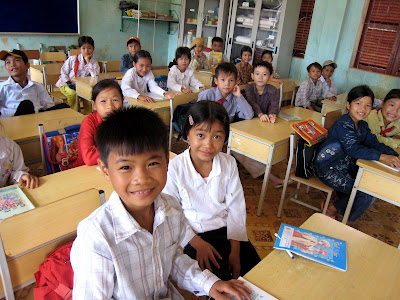By Nguyen Thi Hong Phuong, ChildFund Vietnam
and David Hylton, Christian Children's Fund
This is the first in a series of blog entries detailing the day in the life of 11-year-old Nam. Nam is one of more than 18,000 children in 16 communities in the northern mountainous areas of Vietnam, where ChildFund Vietnam is working to create better lives with programs in education, water and sanitation, livelihood, health and child protection.
Christian Children’s Fund works with ChildFund Alliance partner ChildFund Australia in Vietnam. The area we work in is less than 100 miles from Hanoi, the nation's capital.
On this particular day Nam is beginning a new grade level.
and David Hylton, Christian Children's Fund
This is the first in a series of blog entries detailing the day in the life of 11-year-old Nam. Nam is one of more than 18,000 children in 16 communities in the northern mountainous areas of Vietnam, where ChildFund Vietnam is working to create better lives with programs in education, water and sanitation, livelihood, health and child protection.
Christian Children’s Fund works with ChildFund Alliance partner ChildFund Australia in Vietnam. The area we work in is less than 100 miles from Hanoi, the nation's capital.
On this particular day Nam is beginning a new grade level.
 6 a.m.
6 a.m.Nam, an 11-year-old Muong ethnic boy in Xuan Phong, wakes up early and eagerly prepares to go to school. He will have his first lessons in the sixth grade. A long session of mathematics doesn’t seem to lessen Nam’s eagerness for his new school.
“I like secondary school because I feel I am older and more independent. I have new friends, play more grown-up games, and the lessons and teachers are different,” Nam says. “I do miss my primary school, my classroom and my teachers. But if I hadn’t gone to primary school, I would not have had the chance to continue studying and would not have the opportunity for high school. Then, I would not have a job for my future.”
Primary school is free in Vietnam. However, the affordability for children’s schooling is limited in rural mountainous areas due to other shared expenditures such as school construction costs, text books, electricity, water and other fees. These contributions are a burden for poor families like Nam’s, whose monthly income is less than $30.
Tinh, the headmaster of Xuan Phong primary school, said: “Since we’ve had ChildFund projects, we have more children going to school. This is because of two reasons. First, the school is much better in terms of teachers’ capacity and infrastructure. We have concrete-built and well-equipped classrooms, clean water and hygienic toilets. Our teachers are trained to improve their teaching methodologies. Now, children’s families are more capable to send their children to school. ChildFund has helped increase families’ income.”
Tinh says children are provided with text books, school bags, and school uniforms, which ease the difficulties of family financial contributions for their children’s schooling.
Nam’s father Duong also recalled the time when Nam’s elder brother, Dan, went to primary school: “It was a thatched roof and bamboo walled school. The class was so poor. Children from far-off hamlets had to cross long distances to get to school. Children nowadays have better schools. Farther hamlets now have satellite schools where teachers can stay. Both children and teachers don’t have to travel daily to get the remote hamlets, which lengthens the time they are able to teach and learn.”
What’s next: Nam’s busy day continues at home as he helps his family.



No comments:
Post a Comment